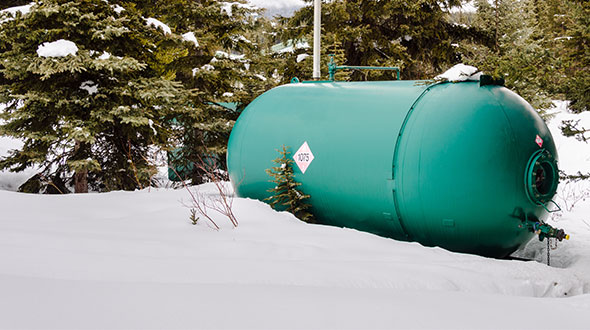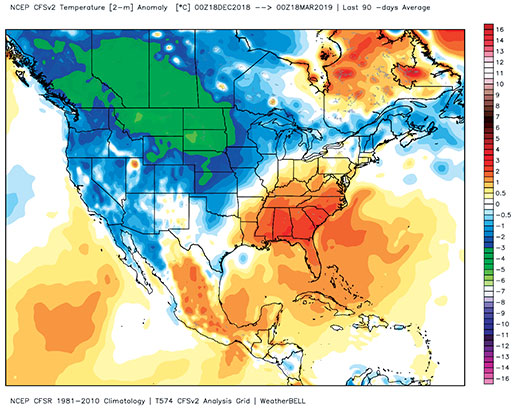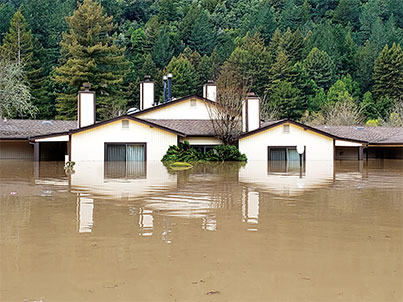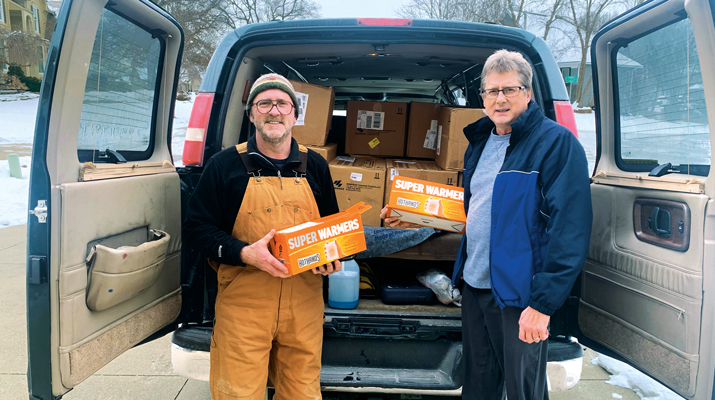Propane industry still strong through past winter heating season

Winter 2019 brought weather challenges, but supply lines hold steady to maintain service. Photo: iStock.com/AlbertPego
Although this past heating season brought welcomed load not seen in recent years, propane marketers also faced an assortment of weather-related logistical challenges. There were record-setting levels of rain and snow, along with howling winds, polar vortexes, bomb cyclones, tornadoes, floods, wildfires, mudslides and even a spectacular “ice tsunami” that swept across Lake Erie. Plus, an unusual snowfall frosted portions of Hawaii.
“I think the main takeaway would be that the winter was very volatile,” observes WeatherBELL Analytics Meteorologist Thomas E. Downs V.
The actual conditions you experienced, of course, “could be characterized differently depending on exactly the perspective of the individual and their parochial interests,” he adds.
“Nationally, it was a colder-than-average heating season. If you are sensitive to the Midwest and northern Rockies, then it was a historic winter. If you are more East Coast-centric, it was an average winter. In the Southeast, some people didn’t think winter ever came.”
Downs recounts, “There was a big difference in what happened early on and what happened later on. In November, we had widespread colder temperatures that lasted until the first part of December. Then there was a stretch where it was pretty mild, and then in late January and February, it ended up being very cold.”
And as spring arrived, a series of scattered weather extremes culminated in deadly and destructive Midwestern floodwaters, including the declaration of disaster zones in 64 Nebraska counties.
“It’s been pretty terrible,” says Lynne Schuller, executive director of the Nebraska Propane Gas Association, assessing the flooding in mid-March. “Some communities they can’t even access right now,” she reports, referencing two propane providers with service areas that were especially impacted by the flood and the resulting evacuations, dislodged tanks and mangled piping. “It could be May or June before they’re up and running for everybody.”
Yet, she expresses confidence the industry will competently rectify the situation: “It’s been scary and pretty devastating, but we’re pretty resilient.”
It appears that just about every residential or commercial account across the nation was able to obtain the necessary amount of propane throughout the winter months as supply remained steady and ultimately accessible.
“It’s out there somewhere, you just have to locate it and truck it somewhere,” notes Greg Noll, executive vice president of the Propane Marketers Association of Kansas and member of the LP Gas magazine Editorial Advisory Board.
“Like most parts of the country, Kansas had its first good winter in a while. We had more snow this year than the last three years combined,” he says. “We’ve been preaching, ‘Be prepared, be prepared, be prepared,’ and most of the marketers were prepared,” according to Noll, pleased with the industry’s readiness. “It’s nice to have cold weather, and it’s even nicer to have product that’s available.”
Arranging multiple supply lines in advance of the season and ensuring timely deliveries proved to be important factors.
“Both of these played a role in the success of marketers having a good season,” adds Noll.
On-time trains
New England was also ready for the cold.
“Our members were prepared going into the winter with multiple points of supply and logistical backup,” says Leslie Anderson, president and CEO of the Propane Gas Association of New England. “Supply trains were running on schedule with an adequate lineup of tankers, bringing critical efficiencies to the region’s distribution chain.”
Temperatures in New England were slightly colder than normal and brisker than last year, with typically four straight days of cold interspersed with two or three days of relative warmth.
“It gave folks time to catch up with deliveries, so that was a nice benefit on the weather side,” Anderson says.
The weather was less forgiving in New York this year. In late February, New York’s eastern shoreline and the banks of the Niagara River were buffeted by an “ice tsunami,” consisting of a 30-ft. wall of massive ice blocks pushed along by 60-mph winds across Lake Erie, bulldozing docks, streetlights and anything else in its path.
“It was a rough winter up here in these parts,” says Jacob Wendt at Wendt’s Propane & Oil in nearby Sanborn, New York. “Getting deliveries to our customers this year was harder than normal and there were some scramble times, but we were able to come through.”
Spot propane was purchased off the high seas to satisfy surging demand.
“Will-calls were out of control – people were using a ton of fuel,” says Wendt. “People used roughly an extra tank this year, and our [storage] tanks were down to 15 percent during the first big round.”
Logistical challenges were magnified as the company inaugurated a new location in Caledonia, New York.
“We had a few growing pains, but we were able to service all our customers,” Wendt says.
Out on the western front, winter was similarly fierce, offering ample opportunities for propane marketers.
“On the eastern side of Montana and the northeast side of Wyoming, there was that polar vortex cold weather that came through the entire region. We had some record snowfall for the month of February, and our snowpack is at record levels,” says Tom Clark, executive director of the Rocky Mountain Propane Association. “For the most part, everybody’s happy with the way this winter went. There shouldn’t be any leftover gas.”
When supply challenges did arise in the region, it wasn’t until late in the season, when the worst of the winter had passed.
“Supply was good up until the end of February, first of March; our supply gets low when other states have high demand,” Clark explains. “California has had some record increased demand, and there were trucks coming in to take product to California.”
Supply and distribution lines remained intact during an especially nasty weather onslaught that engulfed Colorado and New Mexico.
“Most, if not all, affected marketers pulled their trucks from the road for two days,” says Dan Binning, executive director of the Colorado and New Mexico propane gas associations. “Transport deliveries were delayed for a couple of days as well, but we did not experience HOS [hours of service] issues. The timing of the storm in mid-March – the end of the heating season – allowed for a measured response from marketers and suppliers.”
Going with the flow

This map shows temperature averages from mid-December to mid-March. March was on pace to finish colder than normal. Image courtesy of WeatherBELL Analytics. Click to enlarge.
Propane marketers had to respond flexibly to supply challenges, given such volatile weather conditions across the country.
In South Dakota, for instance, the mercury this season “has been as low as minus-30 and as high as 70,” says Dawna Leitzke, executive director of the South Dakota Petroleum and Propane Marketers Association.
Maintaining the right amount of output has been tough.
“No season goes smoothly; we’re at the end of the pipe,” she points out. “We’re all in the same boat. We had no propane [for a brief period] because the refiners were trying to push all the products up the pipe.”
Leitzke describes how “we do this every fall and every winter – we know how to go with the flow. Some guys told me they were at the terminal for four hours. One guy got in line the night before.”
She’s eager to stress that despite whatever difficulties and long waits take place, “My guys work really hard to make sure their customers never run out of product.”
In the Minnesota market, roads were blocked and deliveries hampered due to record snowfall in February.
“Everything got delayed due to heavy snows in the Dakotas and Montana,” according to Roger W. Leider, executive director of the Minnesota Propane Association. “Sometimes deliveries were delayed for a week or more. The customers didn’t notice anything, but the marketers had to scramble.”
Nevertheless, Leider believes the heating season went well overall and commends suppliers for doing a “darn good job.”
Record-setting fall rainfall levels in Kentucky delayed the grain harvest to the point of diminishing crop drying demand. The summer-fill season, though, was strong enough to ensure that customers’ tanks were full as cooler weather arrived.
“We had several snow events that slowed deliveries, but we did not experience any significant snowfall this winter,” reports Tod Griffin, executive director of the Kentucky Propane Gas Association. “Winter temperatures were more in the normal range, with only one or two really cold snaps, but these did not last long enough to significantly disrupt the propane supply/logistics chain.”
Griffin adds that an HOS exemption in the Midwest during the polar vortex also helped ease some bottlenecks.
Retailers in West Virginia struggled without that benefit for a time.
“Things were a bit dicey at first when regional hours-of-service waivers were issued for states around us but not including West Virginia, leaving the state as an island,” recounts Tom Osina, executive director of the West Virginia Propane Gas Association (WVPGA).
Prompted by WVPGA, state officials eventually granted HOS relief, and marketers in West Virginia were able to meet demand.
Matheson Tri-Gas’ David Bertelsen, whose company has been pilot-testing monitoring equipment at residential accounts, affirms, “We did not have a significant issue through the winter at this point.”
Even in Hawaii, winter brought surprises. A dusting of snow that frosted lower elevations drew considerable curiosity. Yet, propane sales did not register a corresponding rise.
“This is Hawaii; you just put on an extra blanket,” says Darren Ho, owner of Central Maui Propane. “Just because we had snow on the mountain – which is rare – there’s very little heating in Hawaii.”
Load comes from water heating, cooking, clothes drying and other residential uses, plus commercial food trucks and forklifts.
Unless you’re basking in the tropics, though, it’s not too early to start looking ahead to next year’s heating season.
“Propane retailers need to plan and work with their suppliers much more today in order to handle demand spikes, or it can be costly for the retailer,” advises Marty Lerum, managing partner at Propane Resources. “A propane retailer who can estimate their usage and perform on a monthly basis is more valuable to their suppliers. And higher product security and/or lower product costs will go to the propane retailers that are more valuable to their suppliers.”
Ferrellgas crew braves California floodwaters to retrieve tanks
and restore service

Photo courtesy of Ferrellgas
A volunteer contingent of Ferrellgas staffers sprang into unselfish action when California’s Russian River began rushing over its banks amid unrelenting rainfall, isolating the company’s Guerneville service unit.
“We had a five-man team that came out on Tuesday, and we lived there until Friday,” says Dan Davidson, general manager of the Ferrellgas Lakeport branch, recounting his and his son Garrett Davidson’s efforts, along with colleagues Danny Pevehouse, Rick Premock and Chris Kentzel.
“We brought our cots and sleeping bags,” Dan Davidson reports, noting that as 13 to 14 in. of rain fell over a three-day period, it became apparent that the Guerneville facility and its surrounding customer base was in peril. “We had to get our trucks out of the danger zones.”
Quickly leaving Lakeport and heading for Guerneville, Davidson and his team filled a few shopping carts with food to prepare for the mission at hand, which involved retrieving nearly 100 floating tanks and related components and making crucial repairs to ensure that propane service was restored as promptly as possible for the region’s distressed residents.
“All of these little towns sit along the Russian River Valley, and a lot of them got hit,” says Davidson.
Davidson and his crew drove four Ferrellgas bobtails to safety at Nick Barbieri Trucking, a fuel distributor and hauler located on higher ground in Healdsburg that generously donated parking space. The Ferrellgas personnel then returned as a group to Guerneville, where California National Guard troops had been dispatched to aid in evacuations and recovery efforts.
About half of Guerneville’s 4,500 residents had to flee the town.
“The land became an island,” says Davidson. “The roads in and out of Guerneville were completely closed down. We were stranded on this island for a while” as they secured the Guerneville location.
“We experience floods out here on the Russian River quite frequently, and we have a boat that we purchased for just this type of incident,” he explains.
The 12-ft. watercraft performed admirably considering the dismaying amount of infrastructure in disarray.
“We had a lot of trauma with a lot of tanks floating,” Davidson says. “We were finding tanks in neighbors’ yards down the street.”
Restoring the flow of propane was an arduous process.
“The customers’ yards were filled with water, and it’s hard to dig in the ground with all the roots,” he says.
Spiking demand
At Delta Liquid Energy, based in Paso Robles, California, “we were very lucky with lots of rain and some cold weather this year – and some of our service areas even saw snow,” according to marketing manager Allison Platz.
Sporadic supply tightness became an issue when transports and railcars experienced delayed arrivals from Canada and demand started spiking.
“It gets spread real thin when we have cold weather in California. When there’s snow on the ground, it’s always a surprise and customers use a lot of gas,” she says.
“It was like playing a bit of chess or checkers, moving things around,” adds Platz, noting that a rare snowfall even dusted the company’s Las Vegas location. “They saw a little bit of snow, too. Not like we had here in the mountains, but they had some snow.”
Coming on board in 2016, Platz is the fourth generation of her family to work at the company, which was founded in 1936 by her great-grandparents, the late Harry and Iva Platz of Atascadero, California.
















